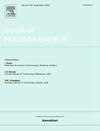Emergency evacuation model of nuclear power plant pedestrians considering emotional infection
IF 2.3
3区 工程技术
Q1 NUCLEAR SCIENCE & TECHNOLOGY
引用次数: 0
Abstract
To examine how panic affects the efficiency of pedestrians evacuation during nuclear power plant emergencies, the emotional infection model, based on the heat dissipation principle, is combined with the social force model. This integration simulates the spread of panic among evacuees in these critical situations. First, the intensity of emotional infection among evacuees is defined based on the social force model. An emergency evacuation model is then developed, incorporating dynamic emotion-driven by quantifying panic levels and including device factors. Additionally, the OCEAN personality model is applied to establish the rules governing emotional infection and to guide the simulation of crowd evacuation. Then, simulation environments for both unit spaces and nuclear power plants are created to analyze how factors including pedestrians density, emotional infection intensity, device factor influence, and the number of exit points affect evacuation efficiency. The results show that the dynamic emotion-driven evacuation model of nuclear power plant pedestrians aligns well with individual movement behaviors during evacuations. In the fixed space scenario, when pedestrians density reaches 0.7/m2, the slope of evacuation time is significantly steeper. In low-density scenarios, emotional infection can enhance evacuation efficiency. Conversely, in medium to high-density situations, once emotional infection intensity surpasses a certain threshold, it negatively impacts evacuation efficiency. Notably, device factors can mitigate emotional infection intensity and improve evacuation outcomes in these denser scenarios. In the emergency evacuation scenario of nuclear power plant, the dynamic emotion-driven model outperforms the traditional social force model, resulting in evacuation efficiency.
考虑情绪感染的核电站行人应急疏散模型
为考察核电站突发事件中恐慌情绪对行人疏散效率的影响,将基于散热原理的情绪感染模型与社会力模型相结合。这种整合模拟了在这些危急情况下疏散人员之间恐慌的蔓延。首先,基于社会力模型定义疏散人员情绪感染的强度。然后开发了一个紧急疏散模型,通过量化恐慌程度和包括设备因素,结合动态情绪驱动。运用OCEAN人格模型建立情绪感染控制规则,指导人群疏散模拟。然后分别建立了单元空间和核电站的模拟环境,分析行人密度、情绪感染强度、设备因素影响、出口点数量等因素对疏散效率的影响。结果表明,核电站行人动态情绪驱动疏散模型与疏散过程中个体的运动行为吻合较好。在固定空间场景下,当行人密度达到0.7/m2时,疏散时间斜率明显变陡。在低密度情况下,情绪感染可以提高疏散效率。相反,在中高密度的情况下,一旦情绪感染强度超过一定阈值,就会对疏散效率产生负面影响。值得注意的是,在这些密集的场景中,设备因素可以减轻情绪感染强度并改善疏散结果。在核电站应急疏散场景中,动态情感驱动模型优于传统的社会力量模型,提高了疏散效率。
本文章由计算机程序翻译,如有差异,请以英文原文为准。
求助全文
约1分钟内获得全文
求助全文
来源期刊

Annals of Nuclear Energy
工程技术-核科学技术
CiteScore
4.30
自引率
21.10%
发文量
632
审稿时长
7.3 months
期刊介绍:
Annals of Nuclear Energy provides an international medium for the communication of original research, ideas and developments in all areas of the field of nuclear energy science and technology. Its scope embraces nuclear fuel reserves, fuel cycles and cost, materials, processing, system and component technology (fission only), design and optimization, direct conversion of nuclear energy sources, environmental control, reactor physics, heat transfer and fluid dynamics, structural analysis, fuel management, future developments, nuclear fuel and safety, nuclear aerosol, neutron physics, computer technology (both software and hardware), risk assessment, radioactive waste disposal and reactor thermal hydraulics. Papers submitted to Annals need to demonstrate a clear link to nuclear power generation/nuclear engineering. Papers which deal with pure nuclear physics, pure health physics, imaging, or attenuation and shielding properties of concretes and various geological materials are not within the scope of the journal. Also, papers that deal with policy or economics are not within the scope of the journal.
 求助内容:
求助内容: 应助结果提醒方式:
应助结果提醒方式:


